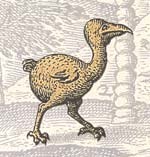
From:
Het-Tweede-Boeck, 1601

Artist:
Joris Joostensz Laerle
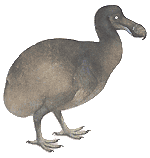
Ustad Mansur 1625
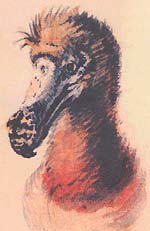
C. Saftleven 1638
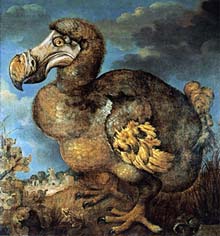 The Dodo by J. Savery 1651
The Dodo by J. Savery 1651

L. Richards
(modern impression)
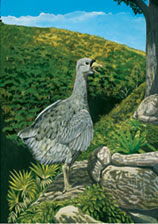
The Solitaire
of Rodrigues
by Julian Hume

The Solitaire
of Rodrigues
by Cassells
The Dodo (Mauritius)
'To be sure, the Dodo was not a lovely creature by our conventional standards of beauty. The bird seemed inept, again by our inappropriate criteria, a waddling creature, incapable of flight and condemned to raising nestlings on the open ground.'
Stephen Jay Gould (1996)
The Dodo looked quite strange and different, but we can only make a reasonably educated guess as to what the Dodo really looked like. The eye-witness accounts and journals described the Dodo in many different ways, and the various etchings and paintings have left us a visual legacy which may not be entirely accurate.
So, what did the Dodo really look like?
The earliest drawings of the Dodo can be found in a publication by T., J.T.
and J.I. de Bry, which was called Het Tvveede Boeck (Amsterdam, 1601).
Another important contribution to the early eye-witness accounts, are the drawings found in the Journal of Admiral Wolfert Harmenszoon, who commanded the second Dutch fleet of five ships to visit Mauritius in 1601. These drawings are the most accurate illustrations of the Dodo that we have, and there is no doubt that these sketches were drawn from live Dodos, or Dodos that had been recently slaughtered.
A miniature by Ustad Mansur, painted while he was working at the Court of the Great Mogul Jahangir between 1615 and 1627, may also be one of the most accurate Dodo pictures that we have.
The most famous artist from this period, who almost made a career out of painting Dodos, was Roelandt Savery of Courtray who was a well-known animal painter. It has never been established that Savery actually painted any of his Dodos from a live specimen, and some evidence points to him painting his first Dodo from a stuffed bird, and all the others were probably copied from this original.
A realistic looking watercolour of the Dodo by Cornelis Saftleven (1607-1681), which is now in the Boymans Museum in Rotterdam, is perhaps one of the last paintings where a live Dodo was observed.
Was the Dodo fat or thin?
Recent research by Andrew Kitchener (1990), Curator of the Royal Museum
of Scotland, showed that the Dodo was a much thinner bird than portrayed
by most painters which led him to hypothesise that the fat Dodos had grown
big on their long voyage, when they would have been fed on ships biscuits
and were probably kept in a confined space, and lacking exercise. Some
have suggested that the action of moulting could certainly be observed
and could have been partly responsible for the differences shown on paintings.
This, and the artist’s natural desire to exaggerate, is probably
the reason why the Dodo was usually portrayed as a very overweight and
plump sort of bird.
What colour was the Dodo?
It is difficult to determine the colour of the Dodo as there is no material
evidence available. Some eye-witness accounts give us the following clues:
• …clothed with grey feathers in the manner of Ostriches.
• …wings and tail a yellowish-white colour.
• …black quills.
• …beak…of a yellowish colour next to the head, with the
extremity black.
Painters showed the body colours from light-blue-grey to a grey-brown; suggesting there may have been a difference between male and female birds.
The Solitaire (Rodrigues)
Recent DNA evidence (Shapiro et al., 2002) has shown that the Dodo and the Solitaire indeed had a common ancestory with the Treronidae family, but actually descended from the Nicobar Pigeon. The two birds ended up on two different islands, with the Mauritian Dodo becoming famous as a symbol for extinction, while its cousin, the Rodrigues Solitaire, remained almost unknown.
'...the sad fate of the Solitaire is particularly regrettable, for though it had not the striking ugliness of the Dodo...the Solitaire was evidently a much more interesting creature.'
Kinn F.(1904)
'The Solitary is a large bird, which weighs about forty or fifty pounds. They have a very big head, with a sort of frontlet, as if of black velvet. Their feathers are neither feathers nor fur; they are of a light grey colour, with a little black on their backs. Strutting proudly about, either alone or in pairs, they preen their plumage or fur with their beak and keep themselves very clean.'
Julien Tafforet [1726]
Bradley Livezy [1993] informs us that of the two birds 'the Solitaire was the heavier bird - the average weight of males is estimated at between 20.9 and 27.8 kg, compared with 15.9 and 21.2 kg for the Dodo. One striking feature is the exaggerated sexual dimorphism; females were only two-thirds as heavy as males, and had much shorter bills.'
For the children.
Click here to download a drawing of the Dodo which you can print and colour yourself (Word document, 786kb).